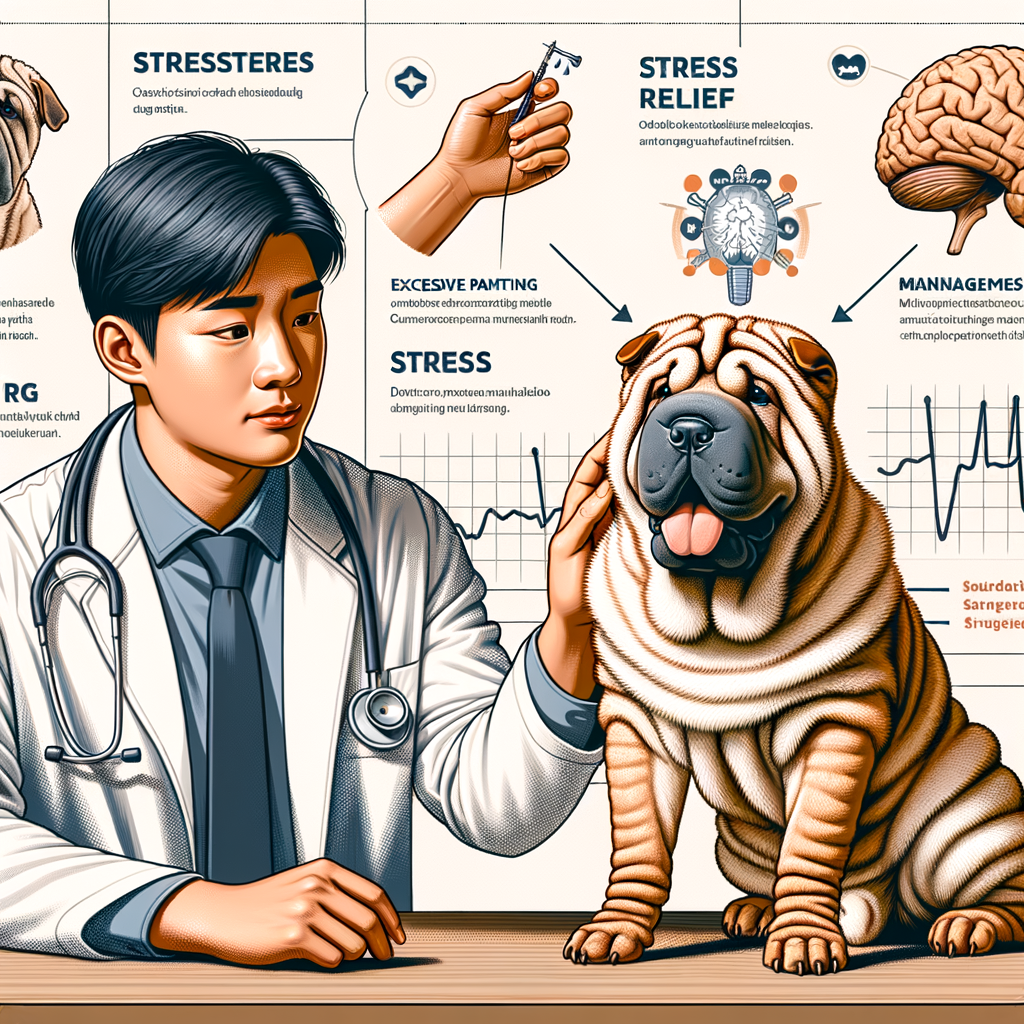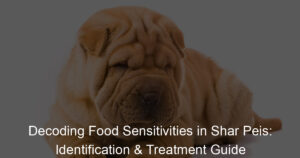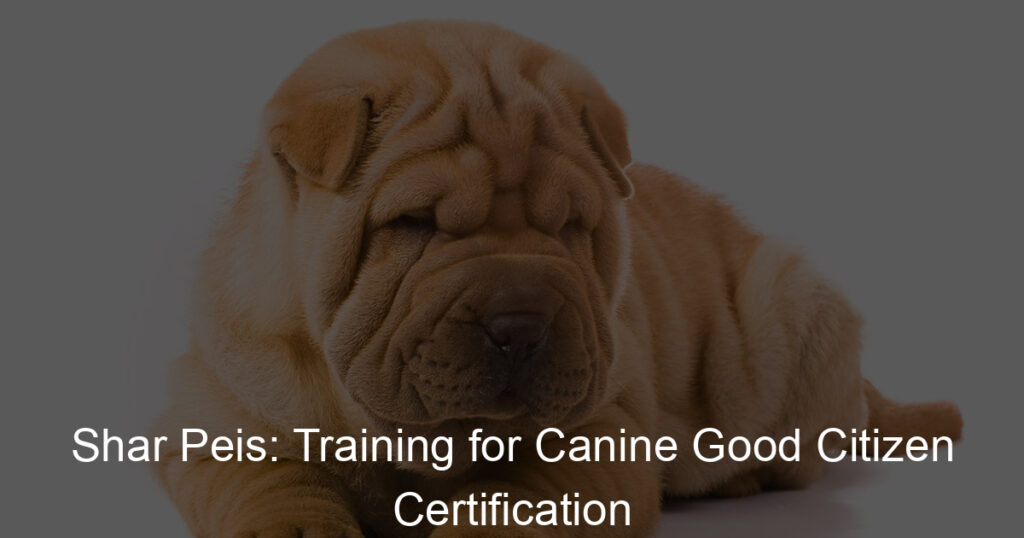
Introduction to Shar Pei Stress Symptoms
Stress is a common issue that affects many dogs, including the Shar Pei breed. It’s essential to understand what stress looks like in these dogs and how to identify its symptoms early. This knowledge can help you take the necessary steps to alleviate your pet’s discomfort and improve their overall well-being.
- Understanding stress in Shar Peis
- Importance of identifying stress symptoms early
Shar Peis, like humans, can experience stress due to various factors. These can range from changes in their environment, such as moving to a new home, to more personal issues like health problems or separation anxiety. Stress in Shar Peis can manifest in several ways, including behavioral changes, loss of appetite, and even physical symptoms like excessive shedding or skin problems.
Identifying stress symptoms in your Shar Pei early is crucial for their health and happiness. Early detection can prevent minor issues from escalating into more serious health problems. It also allows you to take immediate action, such as consulting a vet or implementing stress management techniques, to help your dog cope with their stress. Remember, a happy and stress-free Shar Pei is a healthy Shar Pei.
In the following sections, we will delve deeper into recognizing stress triggers, signs of anxiety, and effective ways to alleviate and manage stress in Shar Peis. We will also share some real-life case studies to provide practical examples of how to cope with Shar Pei stress.
Recognizing Shar Pei Stress Triggers
Understanding the triggers of stress in your Shar Pei is the first step towards managing it effectively. These triggers can be broadly classified into three categories: environmental, physical, and emotional. Let’s delve into each of these categories to gain a better understanding.
- Common Environmental Triggers
- Physical Triggers
- Emotional Triggers
Environmental triggers are often overlooked but can significantly impact your Shar Pei’s stress levels. These can include loud noises, such as thunderstorms or fireworks, which can frighten your pet. Changes in the household like moving to a new home or introducing a new pet or family member can also cause stress. Even a change in routine, like a different feeding or walking schedule, can unsettle your Shar Pei.
Physical triggers are directly related to your Shar Pei’s health and wellbeing. Illness, injury, or discomfort can lead to stress. For instance, Shar Peis are known for their skin folds, which can sometimes lead to skin issues. If your pet is feeling unwell or is in pain, it’s likely to experience stress. It’s crucial to regularly check your Shar Pei for any signs of physical discomfort and seek veterinary care promptly.
Emotional triggers can be harder to identify but are just as important. Shar Peis are sensitive dogs that can easily pick up on the emotions of their owners. If you’re feeling stressed or anxious, your pet may mirror those feelings. Similarly, a lack of socialization or stimulation can lead to stress. Make sure your Shar Pei has plenty of opportunities for play and interaction to keep it emotionally healthy.
In conclusion, recognizing the triggers of stress in your Shar Pei is vital in managing their stress levels effectively. By being aware of these triggers, you can take steps to minimize their impact and help your Shar Pei lead a happier, healthier life.
Signs of Anxiety in Shar Peis
Just like humans, Shar Peis can also experience anxiety. It’s important to recognize the signs early to help your furry friend manage their stress. Here are some common signs of anxiety in Shar Peis:
- Behavioral Changes
- Physical Symptoms
- Changes in Eating or Sleeping Habits
One of the first signs of anxiety in Shar Peis is a noticeable change in their behavior. This could include excessive barking, aggression, or even destructive behavior like chewing on furniture. They may also show signs of restlessness or seem unusually nervous. Remember, these changes could be a sign of stress, so it’s important to take note and consult with a vet if necessary.
Physical symptoms are another common sign of anxiety in Shar Peis. These can include excessive panting, drooling, or shaking. Some Shar Peis may also show signs of discomfort like pacing or trying to escape. It’s important to keep an eye on these symptoms as they can be a clear indicator of stress.
Changes in eating or sleeping habits can also be a sign of anxiety in Shar Peis. They may eat less than usual or have trouble sleeping. On the other hand, some may eat more or sleep excessively. These changes can be subtle, so it’s important to pay close attention to your Shar Pei’s habits.
Remember, every Shar Pei is unique and may show different signs of anxiety. It’s important to know your pet well and consult with a vet if you notice any changes in their behavior or physical condition. Early recognition and intervention can make a big difference in managing your Shar Pei’s stress.
Alleviating Stress in Shar Peis
Stress can take a toll on your Shar Pei’s health and happiness. Fortunately, there are ways to help alleviate this stress, particularly by reducing environmental stressors. Here are some strategies you can implement.
Reducing Environmental Stressors
Environmental stressors can range from loud noises to unfamiliar people or animals. By managing these, you can significantly reduce your Shar Pei’s stress levels.
- Creating a Safe Space
- Minimizing Exposure to Triggers
Just like humans, dogs also need a safe, quiet space where they can retreat when they feel overwhelmed. This could be a specific room, a crate, or a corner with their favorite toys and a comfortable bed. Make sure this space is always accessible to your Shar Pei.
Identify what triggers stress in your Shar Pei. It could be loud noises, strangers, other animals, or even certain situations like car rides. Once you know what these triggers are, you can work on minimizing your dog’s exposure to them. For example, if your Shar Pei is scared of loud noises, try to keep them inside during thunderstorms or fireworks.
Remember, every Shar Pei is unique and what works for one might not work for another. It’s all about understanding your pet’s specific needs and responding accordingly. By creating a safe space and minimizing exposure to triggers, you can help your Shar Pei live a more relaxed and stress-free life.
Physical Stress Relief for Shar Peis
Physical activities can be a great way to alleviate stress in Shar Peis. Two effective methods are through exercise and play, and massage and physical contact. Let’s explore these methods in detail.
- Exercise and Play
Exercise is not just crucial for a Shar Pei’s physical health, but it’s also essential for their mental well-being. Regular exercise helps to burn off excess energy, which can reduce anxiety and stress levels. Playtime can also be a great stress reliever. It allows your Shar Pei to engage in natural behaviors and provides mental stimulation. Try to set aside at least 30 minutes each day for exercise and play. This could include walks, fetch games, or even agility training. Remember, a tired Shar Pei is a happy Shar Pei!
- Massage and Physical Contact
Physical contact can be a powerful stress reliever for Shar Peis. Gentle petting or stroking can help to calm your dog and strengthen your bond. Massage can also be beneficial. It can help to relax tense muscles and promote a sense of calm. Start by gently massaging your Shar Pei’s neck and shoulders, then move down to their back, legs, and tail. Be sure to watch your dog’s reactions. If they seem to enjoy the massage, you can continue. If they seem uncomfortable, it’s best to stop and try again another time.
| Physical Stress Relief Methods | Description |
|---|---|
| Exercise and Play | Helps to burn off excess energy and provides mental stimulation. Aim for at least 30 minutes each day. |
| Massage and Physical Contact | Can help to relax tense muscles and promote a sense of calm. Watch your dog’s reactions to ensure they are comfortable. |
In conclusion, physical activities like exercise, play, and massage can be effective ways to alleviate stress in Shar Peis. Remember, every dog is unique, so it may take some time to find the methods that work best for your Shar Pei. The key is to be patient and consistent.
Stress Management for Shar Peis
Managing stress in Shar Peis is crucial for their overall health and happiness. One of the most effective ways to manage stress in these dogs is through proper training techniques. Let’s explore some of these techniques.
Training Techniques
Training a Shar Pei can be a rewarding experience when done correctly. Two of the most effective techniques include positive reinforcement and maintaining a consistent routine.
- Positive Reinforcement
- Consistent Routine
Positive reinforcement is a training method that rewards good behavior. When your Shar Pei behaves well or follows a command, reward them with a treat, praise, or a favorite toy. This encourages them to repeat the good behavior. For example, if your Shar Pei sits when you command it to, give it a treat. This will make it more likely to sit on command in the future.
Shar Peis thrive on routine. A consistent daily schedule can help reduce stress and anxiety in your dog. This includes consistent feeding times, walks, playtime, and bedtime. A predictable routine gives your Shar Pei a sense of security and helps them understand what to expect each day. For instance, if you always feed your Shar Pei at 8 a.m. and 5 p.m., they will start to anticipate meal times and feel less anxious.
Remember, every dog is unique and what works for one might not work for another. It’s important to be patient and consistent with your training techniques. Over time, you’ll learn what works best for your Shar Pei and help them lead a less stressful life.
Medical Interventions
When it comes to managing stress in Shar Peis, medical interventions can play a crucial role. These interventions often involve two main steps: consulting with a vet and exploring medication options. Both steps are important in ensuring the well-being of your pet.
- Consulting with a Vet
- Medication Options
Firstly, it’s important to consult with a veterinarian if you notice any signs of stress in your Shar Pei. Your vet is a professional who understands the health needs of your pet. They can provide a thorough examination, identify any underlying health issues that might be causing stress, and suggest suitable treatment options.
Remember, each Shar Pei is unique. What works for one might not work for another. That’s why it’s essential to have a vet examine your pet and provide personalized advice.
Secondly, there are various medication options available that can help manage stress in Shar Peis. These medications can range from mild calming aids to prescription drugs, depending on the severity of the stress.
Calming aids are often used for mild cases of stress. They can help your Shar Pei relax and feel more at ease. For more severe cases, your vet might recommend prescription drugs. These medications can help regulate your pet’s mood and reduce symptoms of stress.
However, it’s important to note that medication should be used as a last resort and only under the guidance of a vet. It’s always best to try non-medical interventions first, such as training techniques and lifestyle changes.
In conclusion, medical interventions can be a valuable tool in managing stress in Shar Peis. By consulting with a vet and exploring medication options, you can ensure your pet’s well-being and improve their quality of life.
Coping with Shar Pei Stress: Case Studies
Let’s delve into the real-life experiences of Shar Pei owners who have successfully managed their pet’s stress. These case studies will provide practical insights and strategies that can be applied to your own situation.
-
Case Study 1: Overcoming Separation Anxiety
Meet Max, a three-year-old Shar Pei who used to suffer from severe separation anxiety. Whenever his owner, Sarah, left the house, Max would become extremely anxious and start to bark incessantly, chew furniture, and even try to escape.
Sarah decided to seek the help of a professional dog trainer. The trainer suggested a gradual desensitization approach. This involved Sarah leaving the house for short periods of time and gradually increasing the duration. She also started using a special toy filled with treats that would keep Max occupied when she was not around.
After several weeks of consistent training, Max’s separation anxiety significantly decreased. He no longer showed destructive behavior when Sarah left the house. This case demonstrates the effectiveness of professional guidance and consistent training in managing Shar Pei’s separation anxiety.
-
Case Study 2: Dealing with Fear of Loud Noises
Next, we have Bella, a two-year-old Shar Pei who was terrified of loud noises, especially thunderstorms and fireworks. Her owner, John, noticed that Bella would tremble, hide, and refuse to eat during these events.
John consulted with a veterinarian who recommended creating a safe space for Bella during these noisy events. This included a quiet room with comfortable bedding, her favorite toys, and some calming music. John also started using a special anxiety wrap for Bella, which helped to calm her during these stressful events.
With these measures, Bella’s fear of loud noises has significantly reduced. She no longer hides or refuses to eat during thunderstorms or fireworks. This case highlights the importance of creating a safe and comfortable environment for Shar Peis dealing with fear of loud noises.
These case studies highlight the importance of understanding your Shar Pei’s specific stress triggers and finding effective ways to manage them. Remember, every Shar Pei is unique, and what works for one may not work for another. It’s all about finding the right approach for your furry friend.
Conclusion: The Importance of Addressing Shar Pei Stress
As we draw to the end of our discussion on Shar Pei stress, it’s important to understand the gravity of this issue. Stress in Shar Peis is not just a minor inconvenience. It can lead to serious health problems and a diminished quality of life for these beloved pets. Therefore, addressing it promptly and effectively is crucial.
- Summary of Key Takeaways
- Shar Peis can experience stress just like humans, and it can manifest in various physical and behavioral symptoms.
- Common triggers of stress in Shar Peis include changes in environment, lack of exercise, and separation from their owners.
- Signs of anxiety in Shar Peis can range from excessive barking and chewing to more subtle signs like hiding or avoiding eye contact.
- Alleviating stress in Shar Peis involves a combination of regular exercise, a balanced diet, and plenty of social interaction.
- Effective stress management for Shar Peis requires consistency, patience, and understanding from their owners.
- Final Thoughts on Shar Pei Stress Management
Throughout this article, we’ve explored the symptoms, triggers, and signs of stress in Shar Peis. We’ve also discussed various methods to alleviate stress and manage it effectively. Here are the key points to remember:
Managing stress in Shar Peis is not a one-time task. It’s an ongoing commitment that requires a deep understanding of your pet’s needs and behaviors. Remember, every Shar Pei is unique and what works for one might not work for another. Therefore, it’s crucial to observe your pet closely and adjust your stress management strategies accordingly.
Lastly, always remember that love, patience, and understanding are the best remedies for a stressed Shar Pei. With the right approach, you can help your pet lead a happy, stress-free life.














